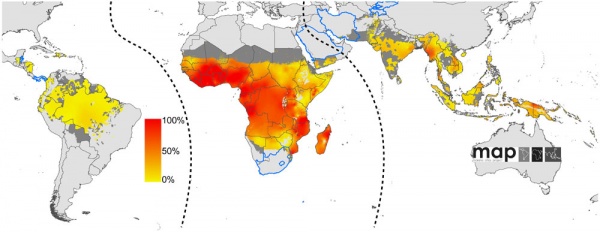Abnormal Development - Malaria: Difference between revisions
| Line 10: | Line 10: | ||
==Some Recent Findings== | ==Some Recent Findings== | ||
{| | |||
|-bgcolor="F5FAFF" | |||
| | |||
* '''Plasmodium vivax malaria'''<ref><pubmed>20386602</pubmed></ref>"Up to 40% of the world's population is at risk for Plasmodium vivax malaria, a disease that imposes a major public health and economic burden on endemic countries. Because P. vivax produces latent liver forms, eradication of P. vivax malaria is more challenging than it is for P. falciparum." | |||
|} | |||
==Placental Infections== | ==Placental Infections== | ||
* Several infective agents may cross into the placenta from the maternal circulation, as well as enter the embry/fetal circulation. The variety of bacterial infections that can occur during pregnancy is as variable as the potential developmental effects, from virtually insignificant to a major developmental, abortive or fatal in outcome. | * Several infective agents may cross into the placenta from the maternal circulation, as well as enter the embry/fetal circulation. The variety of bacterial infections that can occur during pregnancy is as variable as the potential developmental effects, from virtually insignificant to a major developmental, abortive or fatal in outcome. | ||
Revision as of 10:49, 15 October 2010
Introduction
About 10,000 women and 200,000 babies die annually because of malaria in pregnancy, which can cause miscarriages, preterm births, and low-birth-weight births.[1] There are four types of malaria caused by the protozoan parasite Plasmodium falciparum (main), Plasmodium vivax, Plasmodium ovale, Plasmodium malariae. Placental infection is common in regions where malaria is endemic with women carrying their first pregnancy (primigravida).

|
| Global limits and endemicity of P. falciparum in 2007 |
Some Recent Findings
|
Placental Infections
- Several infective agents may cross into the placenta from the maternal circulation, as well as enter the embry/fetal circulation. The variety of bacterial infections that can occur during pregnancy is as variable as the potential developmental effects, from virtually insignificant to a major developmental, abortive or fatal in outcome.
- Pregnant women have an increased susceptibility to malaria infection. Malarial infection of the placenta by sequestration of the infected red blood cells leading to low birth weight and other effects.
References
Bookshelf
Bioinformatics in Tropical Disease Research: A Practical and Case-Study Approach Gruber, Arthur; Durham, Alan M.; Huynh, Chuong; del Portillo, Hernando A., editors Bethesda (MD): National Library of Medicine (US), NCBI; 2008 Control of Gene Expression in Plasmodium
Reviews
Articles
Search PubMed
Search April 2010
Search Pubmed: Placental Malaria
Glossary Links
- Glossary: A | B | C | D | E | F | G | H | I | J | K | L | M | N | O | P | Q | R | S | T | U | V | W | X | Y | Z | Numbers | Symbols | Term Link
Cite this page: Hill, M.A. (2024, April 19) Embryology Abnormal Development - Malaria. Retrieved from https://embryology.med.unsw.edu.au/embryology/index.php/Abnormal_Development_-_Malaria
- © Dr Mark Hill 2024, UNSW Embryology ISBN: 978 0 7334 2609 4 - UNSW CRICOS Provider Code No. 00098G
